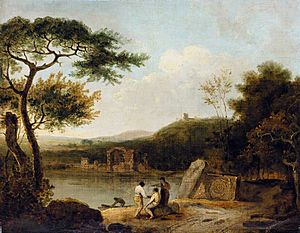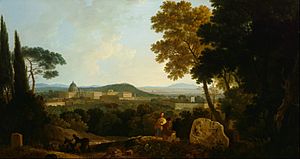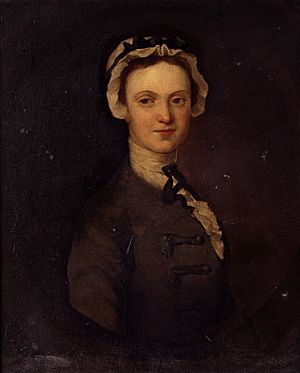Richard Wilson (painter) facts for kids
Quick facts for kids
Richard Wilson
|
|
|---|---|
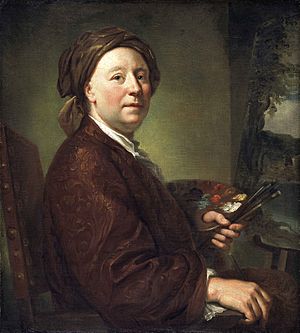
Portrait of Richard Wilson by Anton Raphael Mengs (1752)
|
|
| Born | 1 August 1714 Penegoes, Montgomeryshire, Great Britain
|
| Died | 15 May 1782 (aged 67) Colomendy Hall near Llanferres, Denbighshire, Wales, Great Britain
|
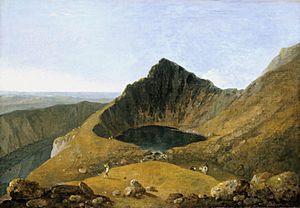
Richard Wilson (born August 1, 1714 – died May 15, 1782) was a very important Welsh landscape painter. He worked in both Britain and Italy.
Many people see Richard Wilson as one of the first British artists to focus on painting landscapes for their own beauty. He was called "the most distinguished painter Wales has ever produced." This means he was considered the best painter from Wales. He was also the first to truly see the artistic beauty of his home country. In December 1768, Wilson helped start the Royal Academy, a famous art institution in London.
Life of Richard Wilson
Richard Wilson was born on August 1, 1714. His father was a clergyman, which is a religious leader. He was born in a village called Penegoes in Montgomeryshire, which is now part of Powys, Wales.
When he was 15, in 1729, Wilson moved to London. There, he began learning to paint portraits. He was taught by an artist named Thomas Wright.
From 1750 to 1757, Wilson lived in Italy. While there, he met another artist named Francesco Zuccarelli. Zuccarelli suggested that Wilson should try painting landscapes instead of portraits. Wilson took this advice and became a landscape painter. He was the first major British painter to focus mainly on landscapes.
Wilson was good at arranging his paintings. He captured the general look of nature, creating his own unique style. This style was influenced by famous artists like Claude Lorrain and Dutch landscape painters. Another famous art critic, John Ruskin, once said that Wilson painted "in a manly way" and sometimes used "exquisite tones of colour."
Wilson mostly painted beautiful Italian-style landscapes. He also painted scenes inspired by old stories from classical literature. One of his paintings, The Destruction of the Children of Niobe (around 1759–60), became very popular. After this, many wealthy landowners asked him to paint their estates in a classical style.
One of Wilson's students was the painter Thomas Jones. Other famous artists, like Constable, John Crome, and Turner, said that Wilson's landscapes influenced their own work.
Richard Wilson passed away on May 15, 1782, at Colomendy in Denbighshire. He is buried near St Mary's Church, Mold in Flintshire.
Famous Works
In 1948, Mary Woodall, who worked at the Birmingham Museum and Art Gallery, put together an important exhibition of Wilson's art.
Some of his surviving works include:
- Landscapes
- Caernarfon Castle
- Cock Tavern at Cheam, which is at the Winnipeg Art Gallery
- Dolbadarn Castle
- Dover Castle
- Lake Avernus with a Sarcophagus, found at the Worcester Art Museum in Worcester, MA
- Lydford Waterfall, Tavistock
- River at Penegoes
- The Garden of the Villa Madama, Rome
- Valley of the Mawddach with Cader Idris
- View at Tivoli
- View in Windsor Great Park
- Cilgerran Castle
- Classical Landscape, Strada Nomentana
- Conway Castle
- Dolgellau Bridge
- The Niagara Falls
- Pistyll Rhaeadr, Aber Falls
- Solitude (also known as Landskip with Hermits)
- Other Paintings
- Ceyx and Alcyone (1768)
- Francis Ayscough, Dean of Bristol and tutor to King George III of Great Britain with his pupils
- Miss Catherine Jones of Colomendy, near Mold (1740)
See also
 In Spanish: Richard Wilson para niños
In Spanish: Richard Wilson para niños


